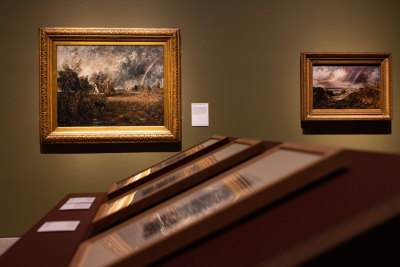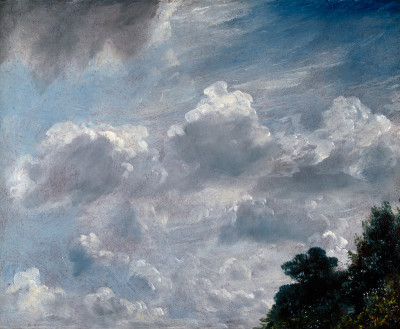Artist of the month: October 2015
Artist of the month: October 2015
George Jones RA (1786 - 1869)
By The RA Collections Team
Published 1 October 2015
Known as ‘Captain Jones’ by his contemporaries, George Jones RA maintained loyalty throughout his life to his two passions, the Royal Academy and the Army.
-
George Jones was born in London in 1786, the only son of the mezzotint engraver John Jones, who was a successful and well-respected figure in the London art world, appointed as Engraver Extraordinary to the Prince of Wales and Principal Engraver to the Duke of York.
Immersed in the contemporary British art scene from a young age, Jones early on demonstrated his aptitude for drawing. He soon enrolled at the RA Schools in 1801, registered as age 17, when he was in fact only 15 years old. Two years later he sent his first works to the Summer Exhibition, but in 1808 halted his training as a painter on obtaining a military commission to join the Army. Age 22, with a strong patriotic streak, Jones enlisted in the South Devon Militia and became a captain in the Montgomery Militia. His company was sent on active service to Paris as part of the Allied Army of Occupation in 1815. He continued to employ his artistic talent by making sketches of buildings, people and views, particularly focusing on the daily activities, dress and actions of the foreign armies in Paris.
-

George Jones RA, The Battle of Hyderabad, 24th March 1843, 1854.
Given by Mrs George Jones, 1870.
Oil on canvas. 110.2 x 210.0 x 30cm. Photo: R.A./Paul Highnam © Out of copyright.
-
Jones retired from his military service in 1815, the same year that the British Institution announced a competition of one thousand guineas to be awarded for “finished sketches illustrative of or connected with the recent successes of the British Army in Spain, Portugal and France”. The prize was set up directly to encourage the genre of battle painting, for which there was no other public patronage. Battle painting was traditionally considered one of the least prestigious genres of art, grouped together with topography and landscape. The early nineteenth-century saw the beginning of a change in attitude and Jones’ combination of military and artistic talents saw him awarded the joint first prize (together with James Ward RA) and a commission to work up his sketches into a large scale canvas to hang in the Royal Military Hospital in Chelsea. Jones’ painting The Battle of Waterloo (1820) was informed by his own encyclopaedic knowledge of the Waterloo campaign. The Duke of Wellington – Jones’ hero – commented on it as “very good – not too much smoke”.
The competition and commission propelled Jones’ reputation as a serious artist and he received several commissions for versions of his Chelsea picture, earning him the nickname “Waterloo Jones”. Established as a leading painter in battle scenes, in 1822 he received a commission from George IV to paint the victories of Vittoria and Waterloo as part of the decorative scheme in the major State reception rooms at St. James’ Palace. This commission may have boosted his prestige within the Academy, as the same year he was elected an Associate.
However, the fees from battle paintings were not enough to live on alone, and Jones also sent small genre scenes to the Royal Academy, often picturesque views in foreign cities. An example of this is his work Malines (pictured). It demonstrates his powers of observation in capturing in detail crowds of people going about their daily activity and his understanding of the picturesque, combined with a rich sense of colour.
-

George Jones RA, Malines, 1867.
Oil on canvas. 91.5 x 71.8cm. Bequeathed by Mrs George Jones, 1874 Photo: R.A./John Hammond © Copyright protected, Royal Academy of Arts.
-
Jones was passionately supportive of and involved in the Royal Academy. From 1834 to 1840 he served as Librarian of the Academy and oversaw a major reorganisation of the books and prints. From 1840 to 1850 he was Keeper of the Schools and regularly visited art schools on the continent to explore new teaching methods; it was on his recommendation that the draped live model was introduced into the Painting School, where previously only copying and still-life painting was practised.
Jones was well-respected and fondly admired among the students, demonstrated in a poem dedicated to Jones written by John Everett Millais, which reads “our aged military Keeper/ And medal distribution weeper/ For whom respect could not be deeper/ In human bones”.
Another painting by Jones also in the RA Collection comes from a series that formed a major part of his oeuvre. The Battle of Hyderabad (pictured) was born out of Jones’ close friendship with the Napiers, a military family. General Sir Charles Napier had earned his military fame in the campaign at Scinde, on the Indian subcontinent, with a series of victories in 1842 to 1843. However, after his return, he was criticised as instigating the war for his own financial and careerist interests. Enraged at the accusations, his brother William devoted his time to defending his brother’s reputation and Jones similarly felt that the successes at Scinde needed to be brought to the wider public attention. With this aim in mind, between 1849 and 1858 Jones sent six works to the Royal Academy based on the Scinde campaign. Four of the six campaigns were accompanied by a note declaring them as being executed under the direction of Sir Charles Napier himself with the Battle of Hyderabad being one of these four. This deliberate declaration of endorsement by the very hero who features as the focal point of each painting is an unusual example of propaganda at the Royal Academy. The action is directed along two diaganols, which show troops streaming into the central focal point of the battle from the right hand side and chasing off into the distance at the left. The fighting is concentrated in the centre of the composition with the landscape stretching out to the rear, enhancing the epic nature of the scene.
A sense of Jones’ character comes through in the various anecdotes of his time at the Academy. He maintained his title of “Captain” and his military association was not hindered by his remarkable resemblance to his hero the Duke of Wellington, to the extent that Harriet Leslie joked “…he was afraid to go out on the day of the Duke’s funeral for fear they should bury him.” He took his duties as Keeper seriously, judging by reports that the Captain patrolled the Schools at night with a drawn sword. The bust of George Jones by Henry Weekes RA, exhibited the year after his death, demonstrates the fondness and regard in which he was held.
-

Henry Weekes RA, Bust of George Jones RA, 1870.
Given by Mrs George Jones, 1870.
Marble. 71 x 54 x 32cm. Photo: R.A./Paul Highnam © Copyright protected, Royal Academy of Arts, London.
-
October’s Object of the month is After Francesco Laurana, Bust of a Woman, possibly Ippolita Maria Sforza, c. 1473. See more from the RA Collection.






